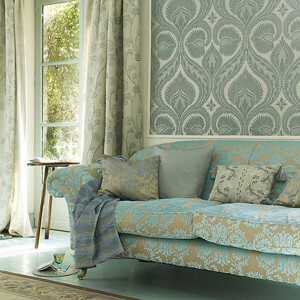
- Care of textile furniture: care products
- How to organize care for different types of textiles on furniture?
- Useful advices:
It is difficult to imagine modern apartments without a beautiful interior element - upholstered furniture, which in any room creates a home environment, a feeling of comfort and peace. However, the worn chairs do not have much to do with a pleasant conversation, and the spools on the back of the couch are more likely to be driven into anguish than to cheer up. To upholstery upholstered furniture for a long time retained its aesthetic appearance, silky shine, it is necessary to carry out the proper care of textiles. Furniture with fabric upholstery has its own specifics, which means it needs special care, which differs from washing plastic, cleaning wood or glass.
to the table of contents ↑Care for textile furniture: care products
So that the silky shine of the material does not lose its pristine beauty:
- The fabric must be regularly treated to remove dust with a vacuum cleaner. It is advisable to carry out preventive cleaning with a vacuum cleaner, using a special attachment with a short pile.
- Upholstery should be periodically wiped with a damp( not wet) foam rubber sponge.
- Remove stains and other contaminants with a soft and dry brush, and clean strong soils with a mild soapy water solution. But you need to use water in limited quantities, so that excess moisture does not leave a stain on the fabric.
Important! To get rid of dust, use the following method:
- Wet and squeeze out the old sheet thoroughly.
- Cover the whole sofa with it.
- Beat with a punch for carpets, a thin stick or even a fly swatter.
Such cleaning will not pick up dust, as it will remain all on the sheet. If the furniture is heavily soiled with dust, repeat the procedure using a fresh, washed and wrinkled sheet.
to the table of contents ↑How to organize the care of different types of textiles on furniture?
 Options for care of the upholstery differ depending on the material from which the furniture is made. Let's consider some properties and features of materials from which upholstery of upholstered furniture can be sewed. Depending on the properties of the tissues and choose a product for the care of textiles.
Options for care of the upholstery differ depending on the material from which the furniture is made. Let's consider some properties and features of materials from which upholstery of upholstered furniture can be sewed. Depending on the properties of the tissues and choose a product for the care of textiles.
Chenille
Chenille is a very dense, durable natural fabric. The material is characterized by wear and beauty. Chenille does not stretch, well sits on upholstered furniture, while the fabric does not form a pellet.
Important! Produce a chenille of threads and villi, which are interlaced on a special machine, as a result of which they become inseparable.
The rules for the care of textiles on furniture are as follows:
- This fabric can not be washed, it is forbidden to wring out and twist.
- In no event, do not bleach.
- It is necessary to dry Chenille at normal temperature( not higher than 60 ° C) and do not use direct sun rays in this process.
Important! For upholstery of furniture made of Chenille, chemical cleaning with hydrocarbon solvents is allowed.
Flock
Flock is a very practical material, pleasant to the touch. Upholstery from the flock does not burn out, repels water and even withstands the onslaught of cat claws.
Care tips:
- Use a vacuum cleaner to remove dust regularly.
- Dust can also be removed using a sponge or a soft brush.
- To prevent damage to pile surfaces, do not use a brush for rough cleaning.
- To ensure the care of such textiles, if furniture is covered with fresh greasy spots, remove them with a little water and a mild soap. After 2-3 minutes, erase the stain in a circular motion, using a sponge or a soft brush. Soap foam soak with a napkin. After the treatment, dry the surface. After the fabric has dried a little, iron the stain through the cloth and restore the pile with a special brush.
Important! Do not scrape the dried stains or stuck pile of material, otherwise you will spoil the fabric.
Jacquard and Tapestry
Both these types represent a rigid and dense fabric made of cotton, natural silk, synthetics and their mixtures.
For jacquard and tapestry upholstery, the following care is recommended:
- Regular wet cleaning once a month. Wipe the textile sofa with a damp cloth moistened with a neutral solution.
- Pile restore with a soft brush.
- Dry cleaning at home: in order to eliminate stains, use a clean hygroscopic cloth, soap solution and distilled water.
- Dry brushing and vacuuming are permissible.
- Jacquard covers can be hand washed at a temperature of 40 C, you can not squeeze the fabric.
Important! To remove stains, do not use detergent chlorine powders and bleaches. Use for this purpose an ordinary soap solution or a textile remedy for water-based furniture.
Charmel
Fabric is 100% composed of high-tech refined fibers. This material is extremely durable and easy to clean and clean. Dry cleaning is recommended for this fabric at home.
Care for this material requires the following rules:
- The fabric can not be ironed.
- The material can not be cleaned with a steamer.
- It is necessary to avoid contact of the fabric with hot water and oil, as well as heat sources: a blanket with an electric heater, a bottle of hot water, a smoldering cigarette.
- Do not scrub the dried dirt, as it can damage the pile.
Suede
 Use a soft-nosed brush to remove dust from the fabric. In the case of heavy upholstery, dry cleaning is recommended.
Use a soft-nosed brush to remove dust from the fabric. In the case of heavy upholstery, dry cleaning is recommended.
Velor
Two types of velor are used for upholstery:
- Cotton.
- Woolen.
The canvas has a velvety surface and is extremely pleasant to the touch. Velor fabrics have high practicality and reliability.
Care of these textiles requires compliance with the following rules:
- Wash and squeeze can be done in short mode, but the water temperature should not exceed 30 C.
- Pollution from the upholstery is eliminated by means designed for cleaning carpets and carpets.
- Remove small dirt with a sponge soaked in soapy water.
- Restore the pile on the velor fabrics with a soft brush.
Booklet
Use a soft-nosed brush to clean the upholstery from the boucle. To remove small contaminants, use a sponge soaked with distilled water, and in case of severe soiling - dry cleaning is recommended.
Fabric Q2
Fabric Q2 is completely made of synthetic fibers and meets the highest quality requirements. Fabric Q2 has the following advantages:
- Durability.
- Resistance to light.
- Color fastness.
- Teflon protection against stains.
- High abrasion resistance.
- Ease of care.
Due to its properties, the fabric does not allow penetrating into its fibers any dirt( except indelible ink).Any dirt is easily removed with a sponge or cloth immediately after their formation. Periodically clean the fabric with a vacuum cleaner, using a special nozzle. Carefully process the edges of the furniture.
Important! All furniture fabrics must be cleaned chemically. Washing of fabrics is not allowed. Be sure to read the product information and the stain removal guide that accompanies the manual.
to the contents ↑Useful advices:
- Before using a textile cleaner on furniture, try its action on a small piece of cloth and allow it to dry. This will make sure that the upholstery is not spoiled( usually a small piece of cloth is attached to the product).
- Wet cleaning with a soft foam sponge, without excessive friction. To dry the upholstery, do not use an auxiliary( hair dryer, sun, etc.) to accelerate drying. Upholstery material must be dried naturally.
- In case of heavy upholstery contamination, please contact the professionals who will provide quick and high-quality services for safe and delicate dry cleaning.
Caring for furniture is a guarantee of its durability. Do not forget about it, and your favorite sofa will last you for many years. And if you do not have enough strength for constant care of upholstered furniture, you can always order or sew self-made removable covers, which can be removed and washed with dirt. This is especially true if there are pets in the house.



